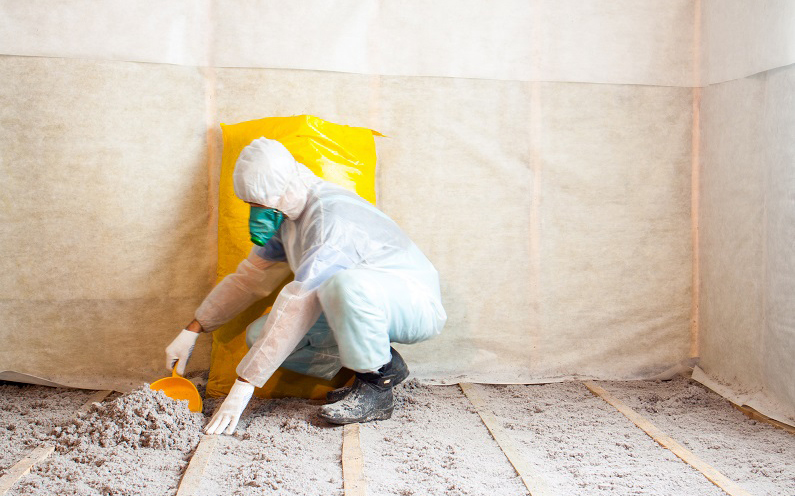
- There are four main types of attic insulation that are used on homes across America.
- As each new form of insulation is developed, it tends to be better than the previous versions.
- Spray foam insulation is the newest form of insulation and is easier to install, is eco-friendly, has a better R rating, and will last longer than other forms of attic insulation.
A poorly insulated house causes high monthly heating and cooling costs. It’s paramount that homeowners invest time in choosing which insulation works best for their home. Which attic insulation performs best, and what are the advantages and disadvantages of each of them? Eagle Insulation has created this blog on your behalf that outlines the 4 most common types of attic insulation, as well as the pros and cons of each.
4 Different Types of Attic Insulation
By the time you’ve finished reading this article, you’ll be able to make an educated decision and contact Eagle Insulation for a free estimate on our insulation contracting job.
Blown in Cellulose Insulation
The material used in cellulose insulation is made from different recycled materials including newspapers and cardboard. Then, boric acid and other substances are applied to the insulation fire resistant. Cellulose Insulation is blown into the attic to cover any small gaps. One benefit of Cellulose Insulation is the eco-friendly recycled material that helps reduce waste. However, Blown-in Cellulose insulation typically performs better than fiberglass, but is still messy to install and can be a pain to maintain. Also, Cellulose also doesn’t mix well with liquid. So, mold can grow quickly thus causing problems for homeowners. Lastly, Blown-in Cellulose is time intensive and can be a messy project for DIY homeowners.
Fiberglass Batt Insulation
Fiberglass batt insulation has many extensive benefits making it the number one choice for most homeowners. Fiberglass is considerably eco-friendly because it is created from sand which counts as a renewable energy source. Also, the vapor barrier is flame-proof and slows the spread of fire. Fiberglass batt insulation rarely shrinks or collapses, and Fiberglass Batt Insulation installment is straightforward. Many homeowners choose to complete the installation process on their own. Fiberglass batt insulation is also soundproof, and helps reduce external noise from entering the home.
However, Fiberglass poses a health risk if inhaled or touched. Furthermore, the vapor that’s used as a barrier can be harmful. This type of insulation doesn’t mix well with condensation or moisture, potentially allowing mold to become a real problem if not properly managed. Rodents and other unwanted animals love fiberglass batt insulation, and often make their home out of the material.
Blown in Fiberglass Insulation
Blown-in Fiberglass uses the same base material (Fiberglass), but it doesn’t require the vapor. It differs based on the distribution method. Rather than being rolled up, it’s blown in through a machine. When using the blown-in method, it fills the attic better, ensuring it’s air-tight. This small switch of distribution to blown-in, can help you save on your monthly energy bill. Blown in Fiberglass fills any cracks or gaps, even in awkward spaces. The blown-in distribution method is far quicker. It takes a matter of hours to get your attic insulation up and running. With fiberglass batt insulation, however, it often takes a few days.
Blown-in fiberglass is considered to be so dangerous, it’s sold with a health risk warning label. After the insulation has settled, It needs more maintenance than other types of attic insulation. If the Blown-in insulation gets wet, removing the insulation isn’t as easy as removing Fiberglass Batts. Blown-in Fiberglass needs consistent maintenance to ensure mold or mildew does not grow.
Spray Foam Insulation
Spray Foam Insulation offers more comfort for homeowners and their families as rooms within the home are better protected from the outside elements. A professionally completed spray foam insulation job allows for precise, long lasting coverage. Spray Foam Insulation has a longer shelf life than the typical pink Fiberglass insulation. Air leaks and improper insulation are a couple of the biggest culprits of high energy bills. Spray foam insulation creates a powerful airtight seal that is measurably less permeable to air infiltration than other types of insulation. Spray foam is not only water-resistant but it’s composed of a polymer that provides no source of food for mold or bacteria. Spray foam is engineered with an inert polymer that allows it to have an ageless lifespan. It helps reduce energy consumption within the household, and protects against moisture and mold growth. Spray Foam insulation is a bit pricier in the beginning, but it’s worth it in the long run because it’s long-lasting. Cheaper forms of insulation have to be changed out on a more frequent basis. So, the long lasting spray foam produces fewer consumed materials and is long term eco friendly.
Spray Foam Insulation Professionals at Eagle Insulation
Not all spray foams are made equal so it’s important to choose an insulation contractor who emphasizes a safe product used within the home. At Eagle Insulation we pride ourselves on offering a great product for a reasonable price while keeping you and your family safe. We will also keep your business & employees safe as we provide commercial spray foam insulation too. The Eagle guarantee is the promise that your home will be warm in the winter and cool in the summer. Schedule a free estimate today to start your spray foam insulation journey. Get ready to save on energy costs and feel increased comfort within your home.
Phone
Address
278 Sawyer Drive #1, Durango, CO 81303
Recent Comments